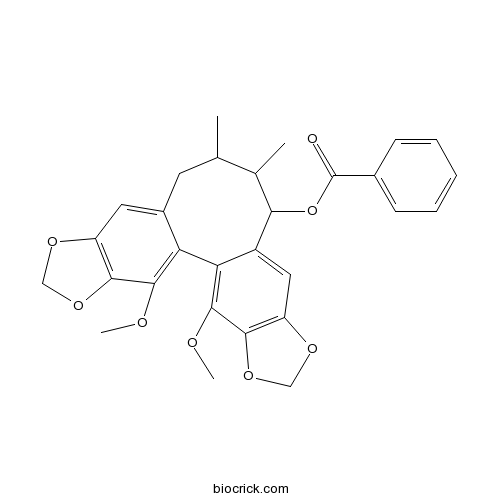Interiotherins ACAS# 181701-06-4 |

Quality Control & MSDS
3D structure
Package In Stock
Number of papers citing our products

| Cas No. | 181701-06-4 | SDF | Download SDF |
| PubChem ID | 177359 | Appearance | Cryst. |
| Formula | C29H28O8 | M.Wt | 504.5 |
| Type of Compound | Lignans | Storage | Desiccate at -20°C |
| Solubility | Soluble in Chloroform,Dichloromethane,Ethyl Acetate,DMSO,Acetone,etc. | ||
| SMILES | CC1CC2=CC3=C(C(=C2C4=C(C5=C(C=C4C(C1C)OC(=O)C6=CC=CC=C6)OCO5)OC)OC)OCO3 | ||
| Standard InChIKey | MBGKPRSARHEFAG-UHFFFAOYSA-N | ||
| Standard InChI | InChI=1S/C29H28O8/c1-15-10-18-11-20-25(35-13-33-20)27(31-3)22(18)23-19(12-21-26(28(23)32-4)36-14-34-21)24(16(15)2)37-29(30)17-8-6-5-7-9-17/h5-9,11-12,15-16,24H,10,13-14H2,1-4H3 | ||
| General tips | For obtaining a higher solubility , please warm the tube at 37 ℃ and shake it in the ultrasonic bath for a while.Stock solution can be stored below -20℃ for several months. We recommend that you prepare and use the solution on the same day. However, if the test schedule requires, the stock solutions can be prepared in advance, and the stock solution must be sealed and stored below -20℃. In general, the stock solution can be kept for several months. Before use, we recommend that you leave the vial at room temperature for at least an hour before opening it. |
||
| About Packaging | 1. The packaging of the product may be reversed during transportation, cause the high purity compounds to adhere to the neck or cap of the vial.Take the vail out of its packaging and shake gently until the compounds fall to the bottom of the vial. 2. For liquid products, please centrifuge at 500xg to gather the liquid to the bottom of the vial. 3. Try to avoid loss or contamination during the experiment. |
||
| Shipping Condition | Packaging according to customer requirements(5mg, 10mg, 20mg and more). Ship via FedEx, DHL, UPS, EMS or other couriers with RT, or blue ice upon request. | ||
| Description | 1. Interiotherin A inhibits HIV replication with the EC50 value of 3.1 micrograms/mL. |
| Targets | HIV |

Interiotherins A Dilution Calculator

Interiotherins A Molarity Calculator
| 1 mg | 5 mg | 10 mg | 20 mg | 25 mg | |
| 1 mM | 1.9822 mL | 9.9108 mL | 19.8216 mL | 39.6432 mL | 49.554 mL |
| 5 mM | 0.3964 mL | 1.9822 mL | 3.9643 mL | 7.9286 mL | 9.9108 mL |
| 10 mM | 0.1982 mL | 0.9911 mL | 1.9822 mL | 3.9643 mL | 4.9554 mL |
| 50 mM | 0.0396 mL | 0.1982 mL | 0.3964 mL | 0.7929 mL | 0.9911 mL |
| 100 mM | 0.0198 mL | 0.0991 mL | 0.1982 mL | 0.3964 mL | 0.4955 mL |
| * Note: If you are in the process of experiment, it's necessary to make the dilution ratios of the samples. The dilution data above is only for reference. Normally, it's can get a better solubility within lower of Concentrations. | |||||

Calcutta University

University of Minnesota

University of Maryland School of Medicine

University of Illinois at Chicago

The Ohio State University

University of Zurich

Harvard University

Colorado State University

Auburn University

Yale University

Worcester Polytechnic Institute

Washington State University

Stanford University

University of Leipzig

Universidade da Beira Interior

The Institute of Cancer Research

Heidelberg University

University of Amsterdam

University of Auckland

TsingHua University

The University of Michigan

Miami University

DRURY University

Jilin University

Fudan University

Wuhan University

Sun Yat-sen University

Universite de Paris

Deemed University

Auckland University

The University of Tokyo

Korea University
- Valdecoxib
Catalog No.:BCC4441
CAS No.:181695-72-7
- SB 228357
Catalog No.:BCC7036
CAS No.:181629-93-6
- tert-Butyldimethylsilyl Chloride
Catalog No.:BCC2796
CAS No.:18162-48-6
- Isonemerosin
Catalog No.:BCN6550
CAS No.:181524-79-8
- PD 160170
Catalog No.:BCC7284
CAS No.:181468-88-2
- Colutehydroquinone
Catalog No.:BCN8239
CAS No.:181311-16-0
- Taxuspine W
Catalog No.:BCN6937
CAS No.:181309-92-2
- Ginsenoside F4
Catalog No.:BCN2881
CAS No.:181225-33-2
- DEL-22379
Catalog No.:BCC6521
CAS No.:181223-80-3
- Almotriptan Malate
Catalog No.:BCC5045
CAS No.:181183-52-8
- Co 102862
Catalog No.:BCC7439
CAS No.:181144-66-1
- 4,5-Dimethoxycanthin-6-one
Catalog No.:BCN1143
CAS No.:18110-87-7
- Cyclopiazonic acid
Catalog No.:BCC6981
CAS No.:18172-33-3
- (-)-beta-Pinene
Catalog No.:BCN3857
CAS No.:18172-67-3
- 25-Anhydrocimigenol 3-O-beta-D-xyloside
Catalog No.:BCN3436
CAS No.:181765-11-7
- Crotonoside
Catalog No.:BCN6281
CAS No.:1818-71-9
- KC 12291 hydrochloride
Catalog No.:BCC7618
CAS No.:181936-98-1
- DLPC
Catalog No.:BCC7929
CAS No.:18194-25-7
- Sequirin C
Catalog No.:BCN4688
CAS No.:18194-29-1
- Fmoc-Dap-OH
Catalog No.:BCC3187
CAS No.:181954-34-7
- Naringenin-4',7-diacetate
Catalog No.:BCN1144
CAS No.:18196-13-9
- Angenomalin
Catalog No.:BCN8246
CAS No.:18199-64-9
- Ethyl beta-D-fructofuranoside
Catalog No.:BCN1145
CAS No.:1820-84-4
- BL 1249
Catalog No.:BCC7777
CAS No.:18200-13-0
[Chemical constituents of petroleum ether extract of fruits of Schisandra sphenanthera].[Pubmed:22993989]
Zhongguo Zhong Yao Za Zhi. 2012 Jun;37(11):1597-601.
OBJECTIVE: To study the chemical constituents in the fruits of Schisandra sphenanthera. METHOD: The constituents were isolated by their silica gel column, Sephadex LH-20 gel column, and their structures were elucidated by their chemical properties and spectroscopic analyses. RESULT: Twelve compounds were isolated and identified as (+)-anwulignan (1), deoxyschizandrin (2), interiotherin A (3), schisantherin A (4), beta-sitosterol (5), schisantherin D (6), 4-hydroxybenzaldehyde (7), 6-O-benzoylgomisin O (8), schizandronic acid (9), schisanlactone D (10), schisanlactone B (11), kadsulactone A (12). CONCLUSION: Compounds 3, 7, 10-12 were obtained from this plant for the first time.
Two new lignans, interiotherins A and B, as anti-HIV principles from Kadsura interior.[Pubmed:8946749]
J Nat Prod. 1996 Nov;59(11):1066-8.
Two new lignans, Interiotherins A (1) and B (2), along with two known lignans, angeloylgomisin R (3) and schisantherin D (4), were isolated from Kadsura interior. Their structures and stereochemistries were determined from spectral data. Compounds 1 and 4 inhibit HIV replication with EC50 values of 3.1 and 0.5 micrograms/mL, respectively.


